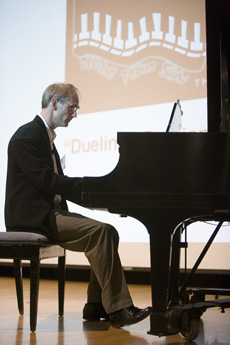Music, opinions ring out at Dueling Pianos event

Fermilab physicist Marcel Demarteau plays "The Storm" by composer Johann
Friedrich Burgmüller as part of the dueling pianos workshop Tuesday night.
Fermilab tried a new tack this week to provide people a relaxed atmosphere to discuss the future of the ILC.
The name of the Tuesday session left many people wondering just what "Dueling Pianos" entailed: a musical revue, a panel discussion or a debate.
The event did not fit squarely into any one of these categories but contained elements of each. It included an address from Director of the Global Design Effort Barry Barish, a piano piece played by Fermilab physicist Marcel Demarteau and questions about future physics projects.
Demarteau welcomed an audience of between 300 and 400 members of the ILC community to what he termed a family event -- an open discussion like one a family might have at a dinner table. He introduced the dueling piano session by describing the connection between dueling opinions and music. "For creative ideas, I go to art for inspiration," Demarteau said before he began to play. "As in music it is the sum total that shapes the piece. The same is here with the ILC. It is work from all over the world that will shape the ILC."
Following the performance, Barish addressed the audience. He described the ILC as a project that involves as much art as science, including the art of problem solving. After Barish's reamrks, Demarteau introduced questions that had been submitted by community members. For each question, two speakers gave answers from different perspectives.
Audience members listened as speakers addressed questions about the positive and negative implications of Fermilab's Project X for the ILC, ways the Global Design Effort should respond to developments in alternative technologies for a linear collider, and what the ILC should do if the LHC indicates that higher energies than the ILC's 500 GeV might be needed.
"Everyone told me afterwards it was a success," Demarteau said. "There was honest and open discussion, which is a step forward."
-- Haley Bridger
|